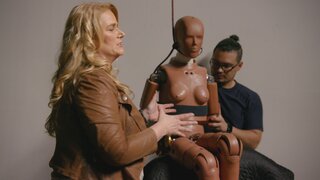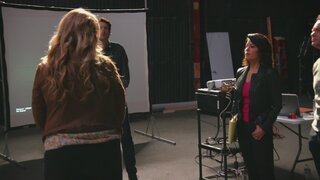Create a free profile to get unlimited access to exclusive videos, breaking news, sweepstakes, and more!
Evidence From The Rebecca Zahau Scene That Raises Questions About If Her Death Was A Suicide
San Diego Sheriff’s Department investigators have concluded twice that Rebecca Zahau died by her own hand at the Spreckels Mansion in 2011.

(Updated March 29, 2023 with news that Zahau's family has formally requested that authorities change the cause of death.)
Rebecca Zahau died in the summer of 2011 at her boyfriend’s Coronado, California, mansion — but whether it was by her own hand or someone else’s remains a mystery.
Adam Shacknai told sheriff’s department investigators that he found his older brother’s girlfriend hanging from a second-story balcony of the mansion on the morning of July 13, 2011. After making the discovery, he told investigators, he called 911, ran to the kitchen to grab a knife, and cut her down, before trying to revive her using CPR.
Investigators ruled the death a suicide, but Zahau’s family disagreed, eventually bringing a wrongful death suit against Adam Shacknai. A civil jury, in a 9-3 decision, found Shacknai liable for Zahau’s death in 2018, but Shacknai has maintained his innocence. During appeal proceedings, Shacknai’s insurance company settled with Zahau’s family for roughly $600,000, according to NBC San Diego — that’s considerably less than the $5 million the jury awarded the family in 2018.
Shacknai still denies any involvement in Zahau’s death.
The family formally sent a request to the San Diego County Medical Examiner's Office asking that they change the manner of death from suicide to homicide or undetermined, according to the San Diego Union Tribune. A change in the manner of death would prompt a fresh look at the case, with Zahau's brother-in-law, Doug Loehner, stating at a press conference, "We want an honest criminal investigation into Rebecca’s case."
The Medical Examiner's Office has maintained the manner of death is suicide.
However, several troubling clues at the scene, from the bindings Zahau was found in to an eerie message written in black paint on her bedroom door, suggested to many that the former eye clinic technician may have met with foul play in her final moments.
“The endgame for this investigation is to get to the truth no matter how thorny it is, no matter how uncomfortable it might be for everyone involved,” Billy Jensen told Oxygen.
Jensen, an investigative journalist, is leading a re-examination of the case with former prosecutor Loni Coombs for the Oxygen series "Death at the Mansion: Rebecca Zahau."
Here are some of the critical pieces of evidence that Jensen and Coombs believe may cast doubt on the suicide conclusion:
1. Zahau was found naked, with her feet bound, hands tied behind her back and a T-shirt stuffed in her mouth
Investigators concluded that Rebecca Zahau took her own life just days after Max Shacknai — the 6-year-old son of her boyfriend, Jonah — plunged over a staircase in the pharmaceutical millionaire’s home while in her care. Investigators said that Zahau was likely wracked with guilt over the accident and, as Max’s prognosis worsened — he later died — she decided to end her life.
Zahau’s family, however, has vehemently denied that explanation and pointed to the unusual physical circumstances surrounding her death.
She was found naked, with a noose tied around her neck, her feet bound, arms tied behind her back and gagged with a T-shirt. An autopsy would also later reveal tape residue and blood on her legs, according to 2011 report from ABC News.
“The single most important thing is there has never been a reported suicide of a female like this,” Amy Bremner, the Zahau family’s attorney at the time, told ABC shortly after the sheriff’s department ruled Zahau’s death a suicide. “Bound hands and feet. Gagged. A noose around her neck. Naked. Blood down her legs. A shirt wrapped three times around her neck. Tied to a bed with neat slip knots and square knots.”
Cold case investigator Paul Holes told Oxygen that for Zahau to have killed herself as described by the San Diego Sheriff’s Department, she would have had to cut several pieces of rope, bind her feet, tie a noose and put it around her neck, along with a T-shirt she had shoved in her mouth.
“Once she's done that, then she has to go through a very complex series of steps to try to tie this complex knot around both wrists, and get that behind her back,” he said.
Finally, she’d have to hop over the balcony and throw herself off of it.
2. The injuries to her neck raise questions
Adam Shacknai has said that on the morning of July 13, 2011, he walked out of the guest house at his brother’s mansion and saw Rebecca Zahau hanging, bound and naked, from a second-floor balcony at the main house.
While Zahau was found with injuries to her neck, some have questioned whether the injuries were severe enough to indicate that she had hanged herself.
“For me, the biggest thing in my mind that I really want to dig into further is the amount of damage to her neck,” Holes said of his concerns with the suicide theory. “If this was this true long-drop execution hanging, I would expect a lot more trauma, if not near decapitation, broken neck, internal decapitation or full decapitation after this victim had dropped nine to 10 feet.”
According to Holes, the forces on the body are “immense” in an execution-style hanging. He believes the evidence “seems more consistent” with manual strangulation, rather than hanging.
Famed pathologist Cyril Wecht also questioned the cause of death after conducting a second autopsy on Zahau’s body.
“Our expert, Cyril Wecht, said she was strangled and was dead or dying before she was lowered off the deck,” Keith Greer, the attorney who represented the Zahau family in the recent civil trial, told Oxygen. “And when I say lowered off the deck, it is because had she gone over the deck on her own, (then) gravity would have carried her down, full-force — it's a nine-foot drop. It would have either ripped her head off or partially decapitated her.”
Greer said there was not a “single dislocated vertebrae in her neck,” which he said doesn’t support the theory of a hanging.
However, the San Diego County Medical Examiner stands behind the initial findings in the case and believes Zahau died from hanging herself.
“The evidence, based upon the abrasions, contusions throughout the body, to me, indicates that Rebecca went face-first over the railing and impacted, slid down the wall, breaking the foliage, as well as leaving marks on the wall before the full length of that rope was reached, and did, in fact, hang herself,” Dr. Glenn Wagner said at a December 2018 news conference to discuss the results of a new review of the case by law enforcement.
The San Diego County Sheriff’s Department re-assessed the case in 2018, after the civil jury’s verdict, but maintained at that news conference that Zahau had died by suicide.
“After a thorough and comprehensive review of all of the existing evidence and searching for potential new evidence, we’re confident that the initial investigation was handled properly, and we’re confident in the science behind our conclusions, the evidence, the evidence collection and the work of the lab,” said Lieutenant Rich Williams, of the sheriff department’s homicide unit. “They all point to a suicide.”
3. Zahau had several hemorrhages on the side of her head
Those skeptical that Zahau took her own life also point to several hemorrhages she had on the side of her head — further evidence, they believe, that someone struck her the night she died.
Keith Greer told Oxygen that after performing a second autopsy on the body, Wecht reported subgaleal hemorrhages, or hemorrhages under the surface of the scalp.
During the civil trial Greer contended that Zahau had suffered four blows to the head, leaving her either partially or fully unconscious, during the alleged attack, according to KGTV.
Wecht also told news station KFBM in 2011, after reviewing the initial autopsy report, that he didn’t believe the injuries could have been caused by hitting branches during her fall, as the county’s medical examiner contends.
"Even if (her) scalp hit bushes, that kind of impact would not produce subgaleal hemorrhage," he said. "We're talking about contusions on the top of the head. So, even as the body is falling down — let's say there are branches — how do you get bruises on the top of the head as the body is falling vertically downward?"
4. Some investigators believe a knife found at the scene with blood on it could indicate sexual assault
Another disturbing clue found at the scene was a knife covered in Zahau’s menstrual blood. The blood was found on all four sides of the knife’s handle, Greer said, suggesting the handle had been used in some type of sexual assault.
According to the San Diego Sheriff’s Department, no fingerprints were found on the knife.
A second, larger knife was also found in the bedroom. Rebecca’s fingerprints were found on the blade of the knife, and crime scene analysts found a mixture of DNA from at least two people on that knife, although the “sample provided an insufficient amount of information for conclusions or comparisons,” Lieutenant Williams said last December.
He added that there was “no evidence of a sexual assault” found in either autopsy of Zahau, who was menstruating at the time of her death, and said the blood could have gotten onto the knife’s handle in other ways.
5. The eerie message written in black paint on the door
At the scene of Rebecca Zahau’s death, someone left an eerie message scrawled across the bedroom door.
The message, written in black paint, read “She saved him, can you save her.”
While the exact meaning of the message is unclear, Greer theorized that it could have been referring to Rebecca’s efforts several days earlier to give Jonah Shacknai’s son, 6-year-old Max, CPR. Max was gravely injured after falling over a banister at the Coronado mansion while in Zahau’s care.
According to the San Diego County Sheriff’s Department, Zahau’s thumbprint was found on the cap of a black paint tube. The paint was also found on her right hand, left breast, right nipple, right upper chest, right upper index finger and neck.
Greer believes that Adam Shacknai painted the message, then applied paint to Zahau.
“It’s like somebody pinched her nipples,” Greer said. “She has black paint there.” He added that paint was also found on the rope, but not on the gag, suggesting the gag may have already been in place.
Despite the analysis of two handwriting experts, it’s difficult to know who wrote the message, because it was painted in block lettering, according to Loni Coombs, who had the message re-examined as part of the Oxygen special.
“The message was so limited and the exemplars were so limited,” Coombs said. “There really weren’t enough points of comparison for an expert to be able to make a strong conclusion.”
5. The Lack Of DNA evidence
Most of the DNA found at the scene was linked to Rebecca Zahau herself. But, it’s the overwhelming lack of DNA in areas of the home that normally would be thought to have DNA that concerned Zahau’s family and the investigators featured in Oxygen’s Death at the Mansion: Rebecca Zahau.
In the civil trial, Greer claimed that surfaces had been wiped to eliminate possible DNA remnants.
“In this case, it’s what the killer didn’t leave behind, which was a huge piece of evidence,” he told Oxygen. “There was no DNA and no fingerprints on just about everything associated with the crime.”
“In this case, we have a lack of physical evidence, whether it’d be latent prints or DNA, to say that there is another person present,” Holes said, adding that the overall scene had “all the hallmarks of a staged crime scene.”
According to Holes, “the absence of evidence is not necessarily evidence of absence.”
Adam Shacknai’s DNA was never found on the knife that he told police he had used to cut Zahau down, but Holes said that when an item is touched it requires “almost a perfect set of circumstances” for fingerprints to be left behind and that contact DNA is “variable” and may not always be left.
“You can have somebody touch an object, and then try to collect DNA and you don’t get it, even though you know that person touched the object,” he said. “Sometimes somebody will touch an object and leave a bunch of DNA.”
6. Adam Shacknai’s Reaction After Finding the Body
Some involved with the case have also questioned Adam Shacknai’s behavior shortly after discovering the body.
On a recording of his call to 911, Adam Shacknai can be heard loudly “huffing” and “puffing,” according to Greer, as he tells the dispatcher that there is a girl who killed herself on the property.
Shacknai also told authorities he administered CPR to Zahau after cutting her down, but investigators in the special have questioned that claim.
“Adam says that he gave Rebecca CPR after he cut her body down from the balcony, and yet none of his DNA is found anywhere on Rebecca’s body,” Coombs said. “That right there is a mystery.”
7. The Knots Used To Bind Zahau
Sheriff’s department investigators contend that Zahau bound herself before hurling herself off the balcony; investigators filmed a demonstration video of how it could have been done with an officer similar in size to Zahau as part of their investigation.
But Greer and Zahau’s family have pointed to the complex knots used to bind her hands behind her back as evidence that someone else — possibly someone with nautical experience — had tied those knots.
Lindsey Philpott, a retired charter boat captain and forensic knot analyst, testified in the civil trial that the overhand and clove hitch knots used to bind Zahau are commonly used for nautical purposes, according to The San Diego Union Tribune.
He believes Zahau had initially been hogtied, although when investigators found the body, her hands were not connected to the bindings on her feet.
Greer pointed to Adam Shacknai’s job as a tugboat captain to suggest he had experience with tying similar knots.
“People tend to get comfortable with one type of knot and use that same knot even if the circumstance calls for a different kind of knot,” Greer said.
But, under cross-examination, Philpott also said that although the knots are commonly used for nautical purposes, they are also simple enough for the layman to tie.
8. Screams Heard By A Neighboring Witness
On the night before Zahau’s body was found, a neighbor reported hearing a woman scream. According to Greer, Marsha Alison, in her 70s at the time, lived two doors down from the Spreckels Mansion, and heard a female call for help.
“She was very adamant that at 11:30 p.m. that evening, she heard a young woman scream three times, ‘Help me, help me, help me,’ generally coming from the direction of the Spreckels Mansion,” Greer said.
But, at the news conference held by the sheriff’s department in December 2018, Williams said that the witness also reported a group of five to six teenagers talking near a sidewalk outside her house the same night.
“A clarifying question that night, one of the first nights of the investigation, confirmed that the voice specifically did not come from the Spreckels Mansion,” Williams said.
While the sheriff’s department continues to maintain that the death was a suicide, investigators featured in Oxygen’s “Death at the Mansion: Rebecca Zahau,” re-examined the case’s most critical details, bringing in experts to evaluate the evidence left behind to help determine just what happened in Zahau’s final hours.
“I’m hoping to get justice for Rebecca,” Loni Coombs said. “I’m hoping to find out the truth of what happened. I’m hoping to find, honestly, the real explanation for what happened here.”


























